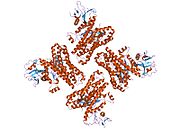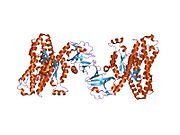RhoC
Ensembl | |||||||||
|---|---|---|---|---|---|---|---|---|---|
| UniProt | |||||||||
| RefSeq (mRNA) | |||||||||
| RefSeq (protein) | |||||||||
| Location (UCSC) | Chr 1: 112.7 – 112.71 Mb | Chr 3: 104.7 – 104.7 Mb | |||||||
| PubMed search | [3] | [4] | |||||||
| View/Edit Human | View/Edit Mouse |
RhoC (Ras homolog gene family, member C) is a small (~21 kDa) signaling
Mechanism and function
It is
Overexpression of RhoC is associated with cell proliferation and causing tumors to become malignant.[10] It causes degradation and reconstruction of the Extracellular Matrix (ECM) which helps cells escape the tissue they are currently in. It enhances cell motility giving it the ability to become invasive.[11] It has been found to have a direct relationship to advanced tumor stage and metastasis, with increases in stage being related to increases in RhoC expression.[12] RhoC-deficient mice can still develop tumors but these fail to metastasize, arguing that RhoC is essential for metastasis.[13] It has also been found to enhance the creation of angiogenic factors such as VEGF, which is necessary for a tumor to become malignant.[12][14] In a study by Vega,[15] RhoC was knocked out which resulted in cells spreading out wide in all directions. When RhoC was disabled, the cell's abilities to move in a specific direction and migrate was impaired. It also reduced the cell's speed of movement, because it was difficult, and sometimes impossible, to polarize the cell.
Associated Signaling Pathways
RhoC expression has been associated with several signaling pathways and effectors. Here is a list of the ones found so far:
- IQGAP1 (IQ-domain GTP-ase Activating Protein): an effector of RhoC to enhance expression of cyclin E and cyclin D1. This resulted in cells being promoted to enter S phase more rapidly [16]
- ROCK-1 [12][17]
- MMP9: necessary for ECM regulation[12]
- FMNL3: a Formin downstream target, which is used to regulate where Rac1 is active [15]
- MAPK pathway: upregulating VEGF, Basic fibroblastic growth factors, and interleukins 6 and 8 expression [14][18]
- Notch1 [14]
- PI3K/AKt pathway: Proliferation and invasiveness [14][19]
- Pyk2: metastasis [14][20]
Types of Cancer RhoC has been studied in
RhoC has been found to be overexpressed in:
- Lung Cancer [11]
- Gastric Cancer [16]
- Ovarian cancer [12]
- Breast Cancer [18][21]
- Hepatocellular Cancer [22]
- Pancreatic Cancer [12]
- Colorectal Cancer [23]
- Cancer of the Urogenital System [12]
- Melanoma [12]
- Prostate Cancer [20]
- Cervical Carcinoma [14]
Potential Therapies
RhoC small interfering RNA (siRNA) have been used in studies to successfully inhibit proliferation of some invasive cancers [16][23] RhoC can be used as a biomarker for judging the metastatic potential of tumors[21][24] One study used "recombinant adenovirus mediated RhoC shRNA in tandem linked expression" to successfully inhibit RhoC [23] It has been found that RhoC expression is not important for embryogenesis but it is only important for metastasis, which would make it a good target for treatments.[14] A RhoC targeted therapy (RV001 by RhoVac) is currently tested in prostate cancer in an ongoing clinical phase 2b program in the US and Europe. Results are expected mid 2022 (Reference: https://clinicaltrials.gov/ct2/show/NCT04114825)
References
- ^ a b c GRCh38: Ensembl release 89: ENSG00000155366 – Ensembl, May 2017
- ^ a b c GRCm38: Ensembl release 89: ENSMUSG00000002233 – Ensembl, May 2017
- ^ "Human PubMed Reference:". National Center for Biotechnology Information, U.S. National Library of Medicine.
- ^ "Mouse PubMed Reference:". National Center for Biotechnology Information, U.S. National Library of Medicine.
- PMID 16949823.
- ^ "Entrez Gene: RHOC ras homolog gene family, member C".
- S2CID 25556221.
- PMID 16212495.
- PMID 18460342.
- S2CID 22119772.
- ^ PMID 14871999.
- ^ PMID 20022093.
- PMID 16107613.
- ^ PMID 19953094.
- ^ PMID 21576392.
- ^ PMID 23145020.
- S2CID 35864555.
- ^ S2CID 211284.
- PMID 17659701.
- ^ PMID 18794150.
- ^ S2CID 9215922.
- S2CID 23715139.
- ^ PMID 20828398.
- PMID 19053170.
Further reading
- Adamson P, Paterson HF, Hall A (1992). "Intracellular localization of the P21rho proteins". J. Cell Biol. 119 (3): 617–27. PMID 1383236.
- Arthur WT, Ellerbroek SM, Der CJ, et al. (2003). "XPLN, a guanine nucleotide exchange factor for RhoA and RhoB, but not RhoC". J. Biol. Chem. 277 (45): 42964–72. PMID 12221096.
- Chardin P, Madaule P, Tavitian A (1988). "Coding sequence of human rho cDNAs clone 6 and clone 9". Nucleic Acids Res. 16 (6): 2717. PMID 3283705.
- Clark EA, Golub TR, Lander ES, Hynes RO (2000). "Genomic analysis of metastasis reveals an essential role for RhoC". Nature. 406 (6795): 532–5. S2CID 4301092.
- Diviani D, Soderling J, Scott JD (2001). "AKAP-Lbc anchors protein kinase A and nucleates Galpha 12-selective Rho-mediated stress fiber formation". J. Biol. Chem. 276 (47): 44247–57. PMID 11546812.
- Kleer CG, van Golen KL, Zhang Y, et al. (2002). "Characterization of RhoC expression in benign and malignant breast disease: a potential new marker for small breast carcinomas with metastatic ability". Am. J. Pathol. 160 (2): 579–84. PMID 11839578.
- Madaule P, Axel R (1985). "A novel ras-related gene family". Cell. 41 (1): 31–40. S2CID 32708060.
- Maekawa M, Ishizaki T, Boku S, et al. (1999). "Signaling from Rho to the actin cytoskeleton through protein kinases ROCK and LIM-kinase". Science. 285 (5429): 895–8. PMID 10436159.
- Reid T, Furuyashiki T, Ishizaki T, et al. (1996). "Rhotekin, a new putative target for Rho bearing homology to a serine/threonine kinase, PKN, and rhophilin in the rho-binding domain". J. Biol. Chem. 271 (23): 13556–60. PMID 8662891.
- Shao F, Dixon JE (2004). "YopT is a Cysteine Protease Cleaving Rho Family GTPases". The Genus Yersinia. Advances in Experimental Medicine and Biology. Vol. 529. pp. 79–84. PMID 12756732.
- van Golen KL, Bao LW, Pan Q, et al. (2002). "Mitogen activated protein kinase pathway is involved in RhoC GTPase induced motility, invasion and angiogenesis in inflammatory breast cancer" (PDF). Clin. Exp. Metastasis. 19 (4): 301–11. S2CID 211284.
- Wheeler AP, Ridley AJ (2004). "Why three Rho proteins? RhoA, RhoB, RhoC, and cell motility". Exp. Cell Res. 301 (1): 43–9. PMID 15501444.
External links
- Laudanna C (2008). "RhoC". AfCS-Nature Molecule Pages. doi:10.1038/mp.a002065.01 (inactive 2024-04-13).)
{{cite journal}}: CS1 maint: DOI inactive as of April 2024 (link - "RhoC : Abstract : UCSD-Nature Molecule Pages". Archived from the original on 2021-12-04. Retrieved 2009-06-16.
















